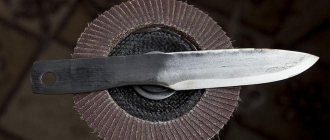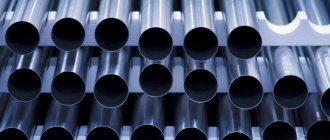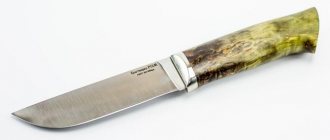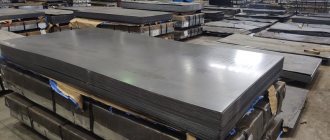Recently you can often hear the expression “ high-speed steel”. What is it? Essentially, these are special alloys designed for the manufacture of metal-cutting tools that operate at high speeds. The characteristics of such a metal should include high strength, wear resistance and resistance to temperature changes.
High-speed steel blanks.
Characteristics of high-speed steels
High-speed alloys have appeared relatively recently. Before their appearance, ordinary steel cutters were used to turn wood or non-ferrous metal products, and some difficulties arose when using them. They had a very short service life due to rapid wear and became very hot, making work at high speeds impossible.
The problem was solved in 1858 after the production of an alloy in which tungsten and manganese were used as the main alloying additives. Over the next decades, through numerous experiments, several types of super-strong metals were obtained, which made it possible to significantly increase the speed and productivity of metal-cutting machines.
The category of high-speed steels includes a large group of alloys that contain alloying elements that make it possible to achieve resistance to wear and high heat. They are distinguished from conventional carbon alloys by their high strength index, which allows the use of tools made from them for processing hard materials.
Quick cut blade.
High-speed cutters have a number of remarkable characteristics by which they can be distinguished from other grades of steel, these include the following:
- Maintaining hardness at high temperatures , so-called hot hardness. Any objects heat up when rubbed. The temperature of a cutting tool operating at high speeds increases very quickly to high levels. When exposed to such heating, ordinary steels are subjected to tempering, which is why they lose their working properties. High-speed steel is not subjected to similar processes, since its composition allows it to withstand temperatures of up to 6000 degrees Celsius without loss of strength.
- High red resistance is a parameter of an alloy, characterized by a time period during which it is able to work at high temperatures without losing its original properties.
- Resistance to destructive processes . In addition to resistance to extreme heat, high-speed cutters must have increased mechanical properties compared to conventional metals. Tools made from such alloys, even under high pressure, do not crumble or break, due to which they are actively used for the manufacture of drills and cutters.
Where are high speed steels used?
The scope of wear-resistant metal depends on the composition that determines its working properties. Basically, this is a tool that has high demands on strength, heat resistance, and long service life.
- Production of drills, cutters, cutters, taps;
- Manufacturing cutting edges for tools, which in some cases can be removable;
- Parts for metalworking machines and equipment;
- Manufacturing of tools used for finishing hard-to-cut metal products.
Experts give the following recommendations on the use of these metal grades:
- Tungsten-molybdenum compounds are suitable for tools intended for roughing products, manufacturing cutters, broaches and shaver.
- Cobalt compounds are used for processing heat-resistant and corrosion-resistant products in difficult conditions.
- Vanadium alloys are used for finishing materials.
- The P9 grade is used to create equipment elements that are not subject to excessive load.
- Grade P18 is suitable for tools with complex shapes and shaped products with increased wear resistance requirements.
The range of metal products is represented by square, circle, strip, and sheet metal. Most often, cutting tools are made from a circle. Square steel is used for the production of electric planers, knives, and turning tools. If you have doubts about the correct choice of a suitable alloy, it is better to contact specialists. Specialized companies will be able to select high-quality rental products with the required performance characteristics.
Decoding the designation of steel grades
High-speed steel was first invented by specialists from Britain. Since tools made from this material required work at high speeds, such alloys were called “rapidsteel” (which means fast steel in Russian). This name, invented in England, was the reason for the modern marking of all high-speed cutting grades with the letter “P”.
According to international regulations, the first digit following P indicates the tungsten content in percent, which is a fundamental element that determines the key characteristics of the entire alloy.
In addition to tungsten, high-speed cutters are characterized by the presence of components such as cobalt, vanadium and molybdenum, which are displayed in the markings by the corresponding letters: K, F and M. Each such letter is followed by a number indicating the percentage of the total chemical composition. As you can see, a person who knows a little about steels, even despite the description, can tell all the basic information about the alloy.
How do HSS drills differ from carbide models?
First of all, HSS drills differ from carbide drills in their material manufacturing technology.
- High-speed steel is produced by adding tungsten, chromium, molybdenum and other components to carbon steel. The material of HSS drills is highly durable.
- Carbide is a composite material made using powder metallurgy technology. It consists of micron-sized particles. The main component is tungsten carbide. Additional ones include titanium carbide, tantalum carbide, etc.
Carbide tools from HSS drills are characterized by higher hardness and heat resistance. However, hard alloys have lower strength. They are afraid of vibrations and force loads. This does not allow the use of carbide drills for intermittent machining of workpieces at high speeds.
Due to the complex manufacturing technology, carbide tools are expensive. Prices for drills made of high-speed steel are much lower.
This is interesting: Stainless steel grades - classification, decoding
Production and Processing Methods
Tools made from high-speed steel are produced using two main technologies:
- The classic method involves casting hot metal into special molds and then further processing and hardening it.
- Powder metallurgy method : molten steel is sprayed under the influence of a nitrogen stream and then melted again.
Powder metallurgy is more complex than traditional metallurgy. The production process involves the production of steel powder, which is blown into a special mold and fused in it. This makes it possible to prevent the occurrence of carbide segregations and make the steel structure more uniform and stable, which has a positive effect on all working properties.
This is what molten steel looks like.
The powder method has a number of advantages that allow it to replace more expensive types of processing, such as casting, stamping and forging:
- cost-effectiveness - even waste, for example, scale, can serve as the starting material for the production of powder, moreover, this method requires less financial costs compared to the classical one;
- achieving more accurate product shapes - parts created by this method do not require further cutting processing;
- high wear resistance.
The production process is necessarily followed by a hardening process . Hardening of high-speed cutting tools takes place at temperatures that contribute to the most favorable decomposition of alloying components in them, but at the same time to the growth of grains in the molecular lattice. After hardening, the structure of high-speed alloys is characterized by a content of up to 30% austenite, and this negatively affects all operating parameters. To reduce the negative impact of austenite to minimum values, two different technologies are used:
- several cycles of heating, holding at a uniform temperature and subsequent cooling are carried out, the so-called multiple tempering;
- Before tempering, the part is cooled to very low temperatures.
Improving product performance
Tools made from high-speed cutters are subject to high demands, and in order for them to meet them to the fullest, their surface is processed. Various methods are used for this, including:
- The surface layer of the part is subjected to nitriding. Such treatment can be carried out in a gaseous environment consisting of either 80% nitrogen and 20% ammonia, or 100% ammonia. The process takes 10-40 minutes at a temperature of 550 – 6600 degrees. This operation makes the top layer less fragile.
- The surface is saturated with carbon and nitrogen - the so-called cyanidation , which occurs by immersing the part in molten sodium cyanide. Depending on the final purpose of the part, cyanidation takes place at different temperatures. The longer the time and the higher the temperature, the thicker the layer becomes.
- Sulfidation is performed in a liquid sulfide melt with the addition of sulfur. This process is carried out from 45 minutes to 3 hours at temperatures from 450 to 5600 degrees Celsius
All of the above procedures are performed with a ready-made tool: the cutting part is sharpened, the surface is polished and hardened.
High speed steel knife.
Decoding: what do the marking symbols mean?
It was already described above what data can be extracted from the name of any brand of high-speed cutters. For greater clarity, let’s consider the decoding of one widely used high-speed steel R9F5:
- R - understandable, designation of high-speed alloys, from the English "rapid" - speed;
- 9 – percentage of tungsten in the alloy;
- F – indicates the presence of vanadium in the steel;
- 5 – percentage of vanadium.
If we analyze the abbreviation R9F5 further, then its decoding may contain other letters. For example, if the metal is obtained by electroslag remelting, another letter appears - “Ш”.
With the introduction of modern technologies, namely the use of nitriding, you can find the following marking R9AF5.
Imported analogues of high-speed cutters have the following marking - HSS, which stands for High Speed Steel, translated into Russian as high-speed steel:
- Germany - 1.3343;
- Japan - S600/S601;
- USA - M2.
Steel marked R9F5.
GOST and TU
Production requirements, technical characteristics, heat treatment process and elemental composition of high-speed steels are regulated by special standards. There are a large number of regulatory documents, since each type of product has its own standard:
- TU 14-11-245-88 - cold-formed high-precision shaped profiles;
- GOST 1133-7 - forged circles or squares, assortment;
- GOST 2590-88 - hot-rolled wheels;
- GOST 7417-75 - calibrated rod;
- GOST 14955-77 - wheels with special surface finishing .
These standards are applied in almost all Russian industries.
Areas of use
- Manufacturing of cutting tools (drills, taps, milling cutters, reamers, replaceable inserts for countersinks).
- Production of structural parts with high wear resistance at elevated temperatures (for example, rings and inserts for automotive valves).
- Die steels for cold deformation processes with a noticeable influence of contact friction (drawing, heading, pressing, extrusion).
Under the stated conditions, high-speed steel must meet the requirements:
- Red brittleness.
- High hardness.
- Compressive strength.
- Impact strength.
- Wear resistance.
To meet these requirements, high-speed cutters often contain cobalt, an active carbide-forming element that is especially active during tempering.
Difficulties in hardening high-speed steel
Heat treatment of high-speed cutters has a number of difficulties associated with the specific application and requirements. For example, heat treatment of P6M5 is complicated by the decarburization property of this alloy (its hardening requires a quarter of the time than similar alloys P18 and P12). The hardening temperature of this metal is 1230 degrees. First, tempering is carried out at 200 and 300 degrees with an hour exposure. Further processing is carried out in 3 stages:
- 3 minutes – 690 degrees;
- 3 minutes – 680 degrees;
- 1.5 minutes – 1230 degrees.
The steel is then cooled in saltpeter, oil and air. Subsequent processing involves three temperings with exposure for 90 minutes at a uniform temperature of 560 degrees. At the tempering stages, the alloy is enriched with alloying additives.
Marking of HSS drills, their types and domestic analogues
All drills made from HSS steel are marked accordingly. There are three varieties of this steel.
- Tungsten (T1–T15).
- Molybdenum (M1–M36).
- Highly alloyed (M41–M62).
Tungsten HSS drills
From this group, drills made from four types of steels are most widely used.
- T1 (domestic equivalent - P18). This HSS steel (18% tungsten) with high characteristics (grindability, strength and wear resistance) is used to make drills and other general purpose tools. They are best suited for machining carbon and alloy structural steels.
- T2 (domestic analogue - R18F2). The alloy contains 2% vanadium. It is used for the manufacture of finishing and semi-finish drills intended for processing medium-alloy structural steels.
- T3 (domestic analogue - Р18K5Ф2). The alloy contains 18% tungsten, 5% cobalt and 2% vanadium. Such tools are characterized by increased secondary hardness and wear resistance, but have low grindability. Drills of this type are best suited for processing workpieces made of high-strength, corrosion-resistant and heat-resistant steels and alloys.
- T15 (domestic equivalent - R12F5K5). This marking on HSS drills means that in addition to 12% tungsten, vanadium (5%) and cobalt (5%) are added to the alloy. These tools are characterized by high strength, toughness and wear resistance. They are used when drilling difficult-to-cut materials.
Image No. 1: composition of tungsten HSS steels
Molybdenum HSS drills
The main alloying component of steels in this group is molybdenum. Also in different quantities may contain:
- tungsten,
- cobalt;
- vanadium;
- carbon;
- and other components.
Image No. 2: composition of molybdenum HSS steels
The most widely used are HSS drills made from the following types of molybdenum high-speed steels.
- M1. General purpose tools are produced from this grade of steel (8% molybdenum). These HSS drills are highly flexible and resistant to impact loads. Red fastness is lower than that of analogues.
- M2 (domestic equivalent - P6M5). This is the most common material for the production of HSS drills. The alloy contains 6% tungsten and 5% molybdenum. It has balanced strength, hardness and heat resistance.
- M3 (domestic equivalent - R6M5F3). This alloy also contains 3% vanadium. HSS drills made from this steel have lower abrasive wear.
- M7. The main alloying components are molybdenum (8.75%), vanadium (2%) and tungsten (1.75%). Drills made from this HSS steel are used for drilling hard and thick sheet metals.
- M35 (domestic equivalent - R6M5K5). In addition to tungsten, molybdenum and vanadium, this alloy contains cobalt (5%), as well as small amounts of manganese, silicon and nickel. The advantages of this material are good toughness, excellent grindability, heat and wear resistance. HSS drills made from this alloy are used when processing workpieces made of improved alloy and stainless steels under conditions of increased heating of the cutting edge.
High alloy HSS drills
To produce high-alloy HSS drills (having high impact strength and operating in cold conditions), molybdenum group alloys are used, which are subjected to special heat treatment.
Image No. 3: composition of high-alloy HSS steels
- M47 (domestic analogue - R2AM9K5). Contains large quantities of molybdenum (9%) and cobalt (4.7–5.2%). The alloy has an increased tendency to decarburization and overheating during quenching. Sandability is low. HSS drills made from this alloy are used for machining workpieces made of improved alloy and stainless steels.
- M42. Contains a large amount of cobalt and molybdenum (8 and 9.5%, respectively). HSS drills made from this alloy are characterized by increased red hardness and abrasion resistance. Such tools are used when processing viscous and complex metals.
This is interesting: Welding stainless steel at home: options, tips, videos
Products that find a place in everyday life and in production
Due to its positive properties, high-speed steel is actively used in knife production . Such cutting tools have all the necessary characteristics. Due to the high resistance of the surface to external loads, they can easily cut thick ropes, wood, bones, etc. They can handle steel plates several mm thick.
A quick-cut knife retains its sharpness for a long time even with intensive use, but it is worth considering that due to its high strength properties it is difficult to sharpen, especially at home.
Quick cutters are widely used in industry. The most striking example is the manufacture of drills for a variety of purposes: from wood to heavy-duty metals. The following parts of industrial mechanisms are made from them:
- hacksaw blades;
- countersinks;
- borax;
- slotting cutters;
- crowns
Recommendations for selecting HSS drills
The following factors directly influence the choice of HSS drills.
- Grade of processed steel. The choice of tool based on the material of manufacture depends on it.
- Equipment that needs to be equipped with a drill. Buy drill bits with shanks that fit the equipment you have.
- Frequency of use. If you are looking for an HSS drill for one-time jobs, inexpensive models are suitable. If you use the tool often, do not skimp on quality.
You will find detailed information about choosing metal drills for various jobs in this article (put a link to the page with article No. 1).
How to sharpen quick cutter products
Even high-speed cutting steel is subject to wear and dullness, despite its impressive strength properties. If we take into account the information about the use and properties of these alloys, we can safely say that it will not be possible to sharpen them using grinding wheels from electrocorundum - the surface after such treatment still remains rough, and the cutting qualities do not improve. What then can we say about manual sharpening?
The most correct option would be to send the product for sharpening to a specialized workshop that has CBN wheels at its disposal. Having such cars in your garage is an unaffordable luxury and simply not advisable. It is better not to try to sharpen it in a garage, as there is a chance of damaging the tool beyond its original state.
Cost of metal in products
Let's look at the cost of metal using the example of one of the most popular high-speed cutters on the domestic market - R6M5. It is not difficult to buy finished products; they are widespread everywhere, but the cost of steel is quite high. Below is an approximate price list.
Depending on the thickness of the sheet, the tool wheel will cost accordingly:
- 2 mm - 1350 rubles per kg;
- 4 mm - 1200 rubles per kg;
- 16 mm – 600 rubles per kg.
The above prices are relative average values. They may change depending on many factors: terrain, economic situation, etc. The high price of high-speed metals makes them popular in the sale of scrap metal. The cost of such secondary products is much higher than that of ordinary alloys.
Previous
KnivesSteel CPM S35VN
Next
KnivesSteel spring 65G







